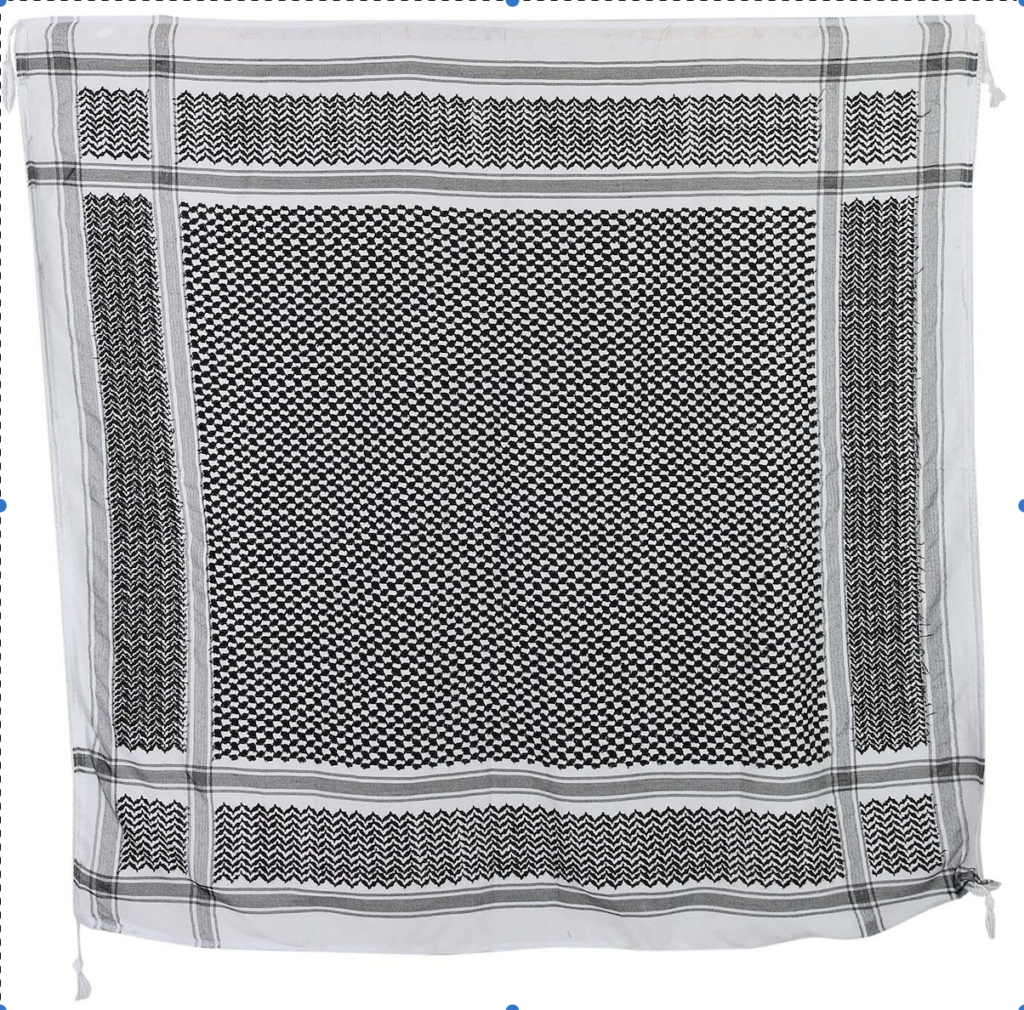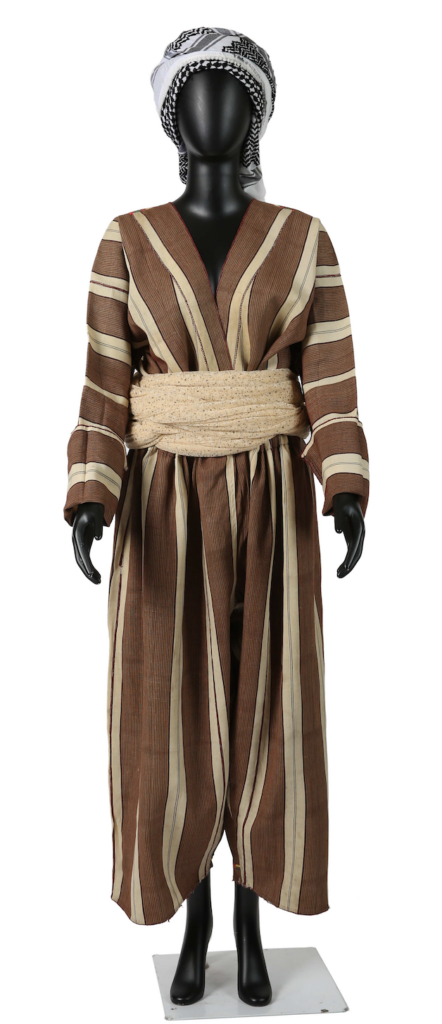In part one of this article, we delved extensively into the historical roots of the Kūfīyah (كُوفِيَّة). We traced its origins back to ancient Mesopotamia in the Tigris-Euphrates River Valley, where it initially served as a utilitarian and protective item before evolving into a symbol of prestige and power. Contrarily, we explored its transformation into an emblem of class struggle during the Ottoman Era, extending beyond its original geographical context. Additionally, we uncovered its evolution into a potent national symbol amid the dynamic shifts in global politics during the early 20th century. In the subsequent second part of the article, we will scrutinise the societal and cultural dimensions of the Kūfīyah (كُوفِيَّة), examining its role in shaping identity and addressing emerging questions.
The Kūfīyah (كُوفِيَّة): Gender Issues and Pop Culture
The Kūfīyah (كُوفِيَّة) evolved into a symbol embraced by Westerners as an emblem of solidarity with the resistance movement. It swiftly became an iconic representation of anti-war activism during the peak of the Cold War throughout the 1960s and 70s. However, the hijacking of a TWA flight in 1969 by the first woman hijacker, Leila Khaled, cast a shadow over the Kūfīyah’s (كُوفِيَّة) image in the Western consciousness. Ironically, as media outlets circulated images of Khaled, a Palestinian refugee and former militant, brandishing an AK-47 and sporting a Kūfīyah (كُوفِيَّة), the gendered perception of the Kūfīyah (كُوفِيَّة) was challenged. No longer confined to being worn solely by men for a cause, it emerged as an accessory suitable for both men and women.
Fascinatingly, the kerchief, a headgear in the Arab world, has consistently been a gender-neutral accessory, embraced by both men and women across centuries. Referred to as ‘hatta (حَطَّة),’ ‘futah,’ and other regional names, its styles and materials vary for women, showcasing regional and communal distinctions.
Cultural Appropriation or A New Identity: A Debate
In the 1980s, the Kūfīyah (كُوفِيَّة) underwent a paradigm shift in the West. Transitioning from its origins as a symbol of the Palestinian cause and anti-war sentiments, it transformed into a broader emblem of liberalism and anti-authority. Embraced by pop culture icons, the Kūfīyah (كُوفِيَّة) became a distinctive accessory within the ‘hipster’ subculture by the early 2000s, frequently spotted in crowds at music concerts alongside Che (Guevara) T-shirts.
While the fashion industry globally witnessed the widespread and unapologetic appropriation of the distinctive black and white patterned fabric throughout the 2000s, the Kūfīyah’s (كُوفِيَّة) transformation into a popular fashion accessory by various brands ignited intense debates too.
It is intriguing to observe the incorporation of symbolism from ancient Mesopotamian fishermen of the Tigris-Euphrates Valley into a Mediterranean context. While the fishnet pattern retains its resonance with the coastal roots of Palestine, the substitution of fish scales with rows of olive leaves holds significant meaning. These leaves symbolise perseverance and endurance, establishing a profound connection to the Palestinian soil and vegetation—an emblematic representation of the region. Additionally, the bold lines, once representative of rivers in the Iraqi context, now take on a new meaning as symbols of robust trade routes in Palestine. Positioned at the crossroads of Europe and Asia since ancient times, these lines encapsulate the historical significance of trade integral to the region.
These observations extended beyond concerns of mere appropriation, delving into complex questions about whether such usage inherently disrespects the political and historical context associated with the Kūfīyah (كُوفِيَّة).
This prompts the inquiry of whether the donning of the Kūfīyah (كُوفِيَّة) for a cause by non-Arabs today constitutes cultural appropriation or transforms the Kūfīyah (كُوفِيَّة) into a broader global symbol of freedom and liberation. An analogy for this debate can be drawn from UNESCO’s declaration of February 21st as International Mother Language Day, which commemorates the 1952 massacre of students in Dhaka, Bangladesh (then East Pakistan), during a rally advocating equal rights for Bengali alongside Urdu in the Pakistani Parliament.
Against the backdrop of a declining Palestinian industry, the Hebrawi Textile factory in Al Khalil/Hebron stands as the solitary producer of authentic Palestinian Kūfīyah (كُوفِيَّة) today, operational since its establishment in the 1960s. As local industries face challenges, the global demand for Kūfīyah (كُوفِيَّة) is predominantly met through the power looms of China. Should this reduce the importance of the Kūfīyah (كُوفِيَّة) as the symbol for the Palestinian cause?
In the wake of escalating global Islamophobia post-9/11, the West has unabashedly associated the Kūfīyah (كُوفِيَّة) with symbols of terrorism and animosity. Amidst ongoing protests and demands on both sides, since the recent clashes starting October 7th, 2023, there has been a growing trend of anti-Islamic sentiments directed at individuals wearing the Kūfīyah (كُوفِيَّة), contrasting with the comparatively unscathed acceptance of the blue and white flag. This situation prompts a crucial question, perhaps the most critical question of all: Does the black and white kerchief exclusively symbolize the cause (liberation from suffering and struggle) of a specific faith community in Palestine?
In conclusion, the Kūfīyah (كُوفِيَّة) continues to transform beyond geographical and material constraints, prompting questions about its meaning and global significance. Much like the watermelon, a symbol echoing the Palestinian flag, the Kūfīyah (كُوفِيَّة) has ventured into new realms of expression. Despite restrictions on its use in political rallies in the West due to perceived ‘provocative imagery,’ it persists in evolving, finding alternative channels like tattoos and henna for its continued expression.
About Rajrupa Das:
Rajrupa Das, a proud Kolkata native, is a dedicated museum professional with a Master of Letters in Dress and Textile Histories from the University of Glasgow. Growing up in Kolkata, a city that beautifully juxtaposes historic charm with modernity, Rajrupa developed a profound appreciation for culture and history. She believes understanding a culture starts with its food and fashion, both deeply influenced by geography and environment. Rajrupa earned her Bachelor in Fine Arts and Art History from the esteemed Government College of Art and Craft, Kolkata. Her experience spans from being a curatorial assistant at Glasgow Museums Resource Centre to working at INTACH and serving as a Museum Coordinator for Women’s Museum UAE in Dubai. Earlier, she contributed to Sabyasachi Couture as a researcher and design analyst and worked in the corporate sector for leading organizations. Rajrupa’s research interests encompass the evolution of dress, textile designs, colonial influences, and innovative museum practices in developing nations.


